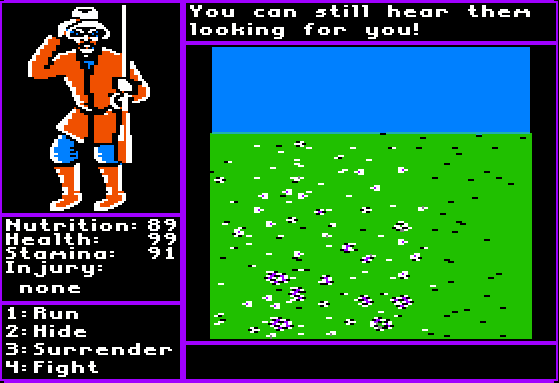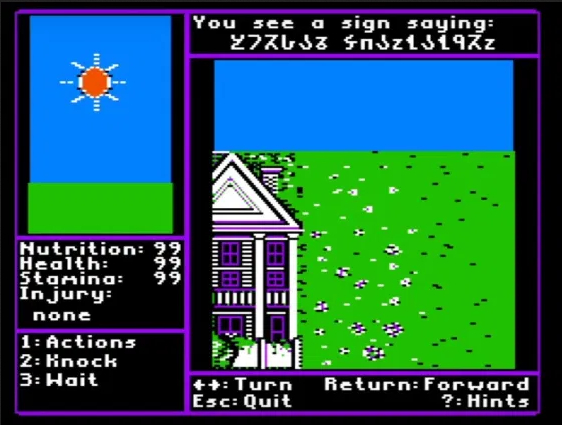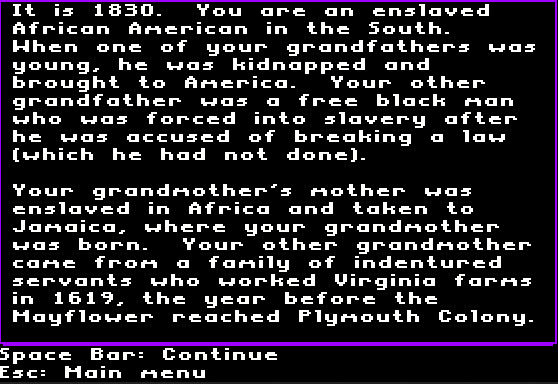In June, screenwriter John Ridley wrote an op-ed for the Los Angeles Times that called on Warner Media to remove the film Gone with the Wind from their new streaming service, HBO Max. Ridley argued that the film – widely regarded as an American classic – “glorifies the antebellum south…[and perpetuates] some of the most painful stereotypes of people of color.” His op-ed led to an online protest that culminated in Warner Media removing Gone with the Wind from HBO Max and reposting the film with a new introductory disclaimer featuring film scholar Jacqueline Stewart.
Advertisement
The success of Ridley’s op-ed points to an idea almost all of us accept: portrayals of history by movies, novels, and television shows have a dramatic effect—rightly or wrongly—on how we remember the past. But can’t the same thing be said about historical video games? Is there a video game equivalent to Gone with the Wind? The answer is: almost. In 1992, the Minnesota Educational Computing Corporation or MECC, makers of The Oregon Trail, released a game called Freedom!. Using many of the underlying mechanics of Oregon Trail, Freedom! followed the journey of a runaway slave in the antebellum south attempting to escape bondage. Unlike Gone with the Wind, Freedom! was made for laudable reasons: to educate grade school students on the history of slavery in the United States, to emphasize that African Americans resisted slavery, and to show how difficult the escape from slavery actually was. Freedom! was also made by conscientious people: MECC’s development team boasted decades of experience creating educational software, and they relied on subject experts and scholarly sources to ensure the game’s historical accuracy. Moreover, Freedom! was made in a compelling way: from a first person perspective, players had to rely on environmental clues and careful resource management in order to traverse a dangerous landscape filled with slave patrollers, dogs, and natural obstacles.
Ultimately, however, Freedom! was a disaster. Shortly after its release in fall 1992, Freedom! encountered heavy criticism and protests for perpetuating racial stereotypes. In early 1993, MECC pulled Freedom! from store shelves and revoked the game’s license for schools across the country.
Advertisement
The story of how Freedom! went from being a worthwhile idea to becoming the object of protest starts in 1983. That year saw the state of Minnesota convert MECC from a state owned nonprofit consortium into a profit-seeking corporation. Originally, MECC was created to provide computer access and software for students within the state of Minnesota. By the early 1980s, however, MECC began to sell licenses for their software to other states, who were eager to introduce computers to their students but lacked proven educational software to run on those machines. Seizing on the opportunity, the state of Minnesota cut MECC loose, and allowed it to pursue the burgeoning educational software market unfettered, so long as the company shared a portion of its profits with the state. It’s common to see educational games left out of popular accounts of the history of video games, but, in terms of both sales and influence, MECC was one of the most successful game companies of the 1980s. By the end of the decade, MECC dominated educational software in America, maintaining lucrative licensing deals with over 1/3 of the school districts in the country. It routinely raked in millions in profits thanks in large part to its sale of history titles such as The Oregon Trail, which sold 65 million copies across all of its iterations. When MECC was purchased from Minnesota by a venture capital firm in 1991, the company aggressively pursued the expansion of its history game portfolio. This expansion took a familiar form, with a series of games borrowing The Oregon Trail name (e.g. Africa Trail, Amazon Trail, Yukon Trail), and The Oregon Trail’s mechanics (i.e. roguelike, resource management, turn-based strategy, high difficulty).
Advertisement
It was in this environment that Freedom! emerged. Given the context of MECC’s bottom line, it makes sense that Freedom! would be a run-based historical simulation. But why make a game about antebellum slavery? In their promotional materials for the game, MECC stated that Freedom! fit in with the company’s commitment “to providing inclusive instructional materials,” and their goal to “portray the experiences and perspectives of people from various cultures.” We can infer here that Freedom! represented a nod to the needs of MECC’s primary customer (i.e. school districts emphasizing multicultural education) as well as an awareness that many of MECC’s previous history titles, namely The Oregon Trail, portrayed a white colonial perspective of the past to the detriment of other groups. The key inspiration for Freedom!, however, didn’t come from financial necessity or even The Oregon Trail, but instead from a new living history event near MECC’s headquarters in the Twin Cities region of Minnesota. In the late 1980s, an activist named Kamau Kambui began to run a live action role play event called Underground Railroad Reenactments (UGRRs) just outside of Minneapolis-St. Paul. These events placed participants in the role of fugitive slaves attempting to escape to freedom during the course of a night. You can learn more about Kambui and UGRRs from this recent and excellent write up in The New Yorker. At some point in the early 1990s, Kambui met MECC designer Rich Bergeron, who used Kambui’s UGRRs as the basis for the history and gameplay in Freedom!. Kambui became the game’s primary consultant, and, as The New Yorker notes, “his influence is clear in the [game’s] emphasis on wilderness survival…period dialect and characters with a distinctly ‘African’ look.”
Advertisement
Given this background, what is Freedom! actually like? You can play the game yourself, if you don’t mind downloading it from My Abandonware and running it on an emulator like AppleWin. If you can't be bothered, you can find a few let’s plays of the game on YouTube.

Either way, what you’ll discover is a game that’s obviously drawing a great deal from The Oregon Trail, but will also leave you wishing for problems with dysentery and snake bites. Freedom! is brutally difficult. You start by choosing your origin point in the south, which can include Delaware, Maryland, or Virginia. The location of your plantation can determine how difficult and time consuming your playthrough will end up being, but regardless of where you decide to start you’ll feel incredible pressure throughout. Your journey to freedom will require you to overcome a near endless stream of slave patrollers, slave patrollers with dogs, slave patrollers with lanterns, water, and “rough” water (usually the ocean, so if you come across this you might as well turn and face whatever version of slave patroller is chasing you). On top of the constant threat presented by the game’s enemies and natural obstacles, you’re also tasked with managing your nutrition, health, and stamina as well as keeping track of which direction you’re headed. If your character doesn’t start with a compass, you’ll be left following the stars or looking at moss on trees to determine north. And as soon as you’re chased by slave patrollers, your character will run directionless until they are either recaptured or escape, in which case you’ll have to find north all over again. Whereas your white player character in Oregon Trail gets to follow a well worn path to the west at a leisurely pace without much beyond environmental hazards to worry about, the position of the black player characters in Freedom! make you feel as though you have to reinvent the wheel with a gun at your head every time you start a new escape.
Advertisement
In the end, however, the controversy that enveloped Freedom! had nothing to do with the game’s incredible difficulty. Instead, most of the controversy related to characters and dialogue that the player encounters before the game even begins. After choosing your starting location, Freedom! presents you with a brief biography for your character and then gives you an opportunity to visit your plantation’s slave elders before starting your run. These elders essentially serve the same purpose as shop owners from Oregon Trail: a source for equipment, food, and useful tips about your upcoming journey north. These elders, however, speak in a dialect and their appearance (created using Apple II’s limited color palette) often resemble racist caricatures of African Americans. In addition to the plantation elders, the player character’s dialogue options often contain broken English, and their starting characteristics, which are randomized, can include an inability to read and write. This characteristic can greatly affect a playthrough as place names and written messages become illegible, making it that much more difficult for the player to complete the game.

With regard to the use of era specific dialect in Freedom!, it’s clear that the development team were expecting at least some pushback from players. The game’s manual, which you can read here, makes special mention of dialect in a section on topics that instructors may want to discuss with their students ahead of playing the game for the first time. This section states that this dialect was included “to maintain a ‘feel’ for the historical period…[and] was highly recommended by our consultant, an African American.” The manual also mentions that the game was play tested by a diverse group of teachers and students in the Twin Cities area before release.
Advertisement
I talked with Clemson Professor Susanna Ashton, an expert on 19th century slave narratives, about the game's dialect. She felt that while the game's dialect was roughly accurate for published slave narratives from the 19th and 20th centuries, the dialect did not necessarily reflect how slaves actually spoke. Furthermore, the reconstructed dialect from these narratives could often have a racist effect even if there was no racist intent. The end result of this influence on Freedom! is a game—without instructor guidance—that can feel and look more like a minstrel show rather than an accurate historical simulation. While the developers were careful to include “cover your ass” language with reference to dialect, they were a bit more cavalier with the types of activities they recommended instructors use to supplement their class’ playthrough of the game. In particular, the manual encourages instructors to have their students “re-enact the institution of slavery” in the classroom, with some students roleplaying as slaveowners and the others roleplaying as slaves. The developers, however, merely recommended that instructors make sure to not let “all the white children be ‘owners’ and all black children or children of color be ‘slaves.’”
Reading the manual for Freedom! reveals both the earnestness of the developers and their naivete. They are convinced of the importance and potential benefits of their game, but they are also hopeful that the game will only be played in an appropriate setting with instructor guidance. In practice, few players of Freedom! ever played with an instructor, let alone read the manual. This issue manifested itself first at Henry P. Fieler Elementary School in Merrillville, Indiana outside of Chicago. At Fieler, Freedom! was added to “the school’s open computer lab, [and] offered as something students could explore with their free time. No curriculum was attached.”
Advertisement
Soon after, a group of African American parents complained to teachers and then to MECC directly that Freedom! was offensive and “Nintendoized” slavery. In particular, the game’s use of dialect and general depiction of blacks “exposed their children to ridicule.” For players of Freedom!, playing the digital past was too often an excuse to resurrect it in real life. The school’s superintendent added that the game trivialized “the pain and suffering these folks went through.” As one parent succinctly put it, “slavery was not a game in our history.” After meeting with the parent group at Fieler Elementary and a representative of the NAACP, MECC pulled the game from stores, and requested customers either return the game to MECC or destroy their copy. An updated version of the game was never released. Freedom! and the controversy surrounding it had a profound effect on MECC’s subsequent development process. In 1994, MECC hired an outside firm to run a focus group for a project called Africa Trek (eventually retitled, unsurprisingly, Africa Trail), which was centered around a 12,000 mile bike journey from north to south Africa. The focus group’s documentation, available at the Strong Library, explicitly references the “adverse public and [school] administrative reaction” to Freedom!, and recommended that Africa Trek should not be marketed “as a way to ‘discover your [African] roots.’” Moreover, the focus group panel strongly advised that “development management should obtain consumer and teacher feedback … as a disaster check” before publishing. As one focus group member summarized, “whenever you try to recreate history, there’s a lot of hostility that comes out.”
Advertisement
Like Gone with the Wind, Freedom! is an example of a work of historical fiction engendering and perpetuating harmful racial stereotypes. Yet MECC’s removal of Freedom! from shelves and computer labs means that the game and the criticism of it have largely been forgotten. MECC had the capability to address the game’s issues, but Freedom! was never rereleased.

Did it deserve a second chance? When considering this question, it’s important to study the history of The Oregon Trail game. Originally created as a supplemental lesson for Don Rawitsch’s junior high history course in 1971, The Oregon Trail game famously debuted without mention of Native Americans, or the wider racial and ethnic implications of westward expansion. Yet as the decades past, and the game’s popularity grew, new versions were created that addressed not only the game’s mechanical shortcomings but many of its worst historical faults as well. To a large extent, The Oregon Trail was iterated out of controversy.Freedom! never got that opportunity. But maybe it should have. Intent matters here. Gone with the Wind was made to romanticize a nonexistent past. Freedom! was made to educate players on an important, and depressingly under-taught topic. To a certain extent, the game’s failures were part and parcel of how little African American history was taught in schools to begin with. As one Henry P. Fieler parent argued in 1992, “What I’d like to see is an African-American curriculum in the school system period, before a slavery game can be used as an educational tool.” In reading the original criticism of Freedom!, there’s a case to be made that parent concerns in 1992-93 related not just to the game’s depiction of black Americans, but also the fact that this depiction was in a game to begin with. Freedom! may have been an educational game, but it was released right in the middle of one of America’s great, periodic hysterias about games in general, thanks to titles like Mortal Kombat, Night Trap, and Wolfenstein 3D. While America’s opinion on games and gaming have improved since the early 1990s, recent events in Minnesota and elsewhere have shown that not much has changed with education on topics like slavery and reconstruction since Freedom! was released. This problem is a big reason why educators continue to awkwardly and often disastrously attempt their own classroom roleplay games centered around antebellum slavery. They look to games and gaming as a way to make up for failures with textbooks and traditional instruction. One of the better examples of this work is the publicly funded Mission US game Flight to Freedom, a flash game that follows a slave’s escape to freedom, but also deftly updates the character’s spoken language to avoid the controversies with dialect found in Freedom!. Popular game developers, for their part, are eager to engage with the past, but only if the history is profitable and they can find cover for mistakes behind nebulous, catchall disclaimers (i.e. this game was “designed, developed, and produced by a multicultural team…”). Maybe historical knowledge—real historical knowledge that could change society—can’t exist in popular games. Maybe it can’t even exist in educational or serious games. Maybe society has to change first: games can be an educational supplement, but there has to be something to supplement. The story of Freedom! highlights how at once the game's message was absolutely necessary, but by itself was also insufficient to its purpose. Even an experienced team of developers relying on expert knowledge published a game that had to be pulled from the shelves. There's an irony here. Jacqueline Stewart’s introduction for Gone with the Wind on HBO Max argues that the problematic film should remain available because it shines a light on the racial inequalities that existed at the time of its production and the inequalities that continue to this day. The same can be said of titles like the original Oregon Trail, where the absence of indigenous people and slavery can be used to criticize the game as well as entrenched narratives of westward expansion. In the right hands, even badly flawed games and toxic works of art can still be used to teach history. But that history will still often be taught in relation to the white mythmaking and stereotyping that erased and reduced marginalized people. Freedom!, which (however imperfectly) attempted to center the experience of fleeing slaves and highlight the horrors of the antebellum United States, remains a little-seen historical curiosity.